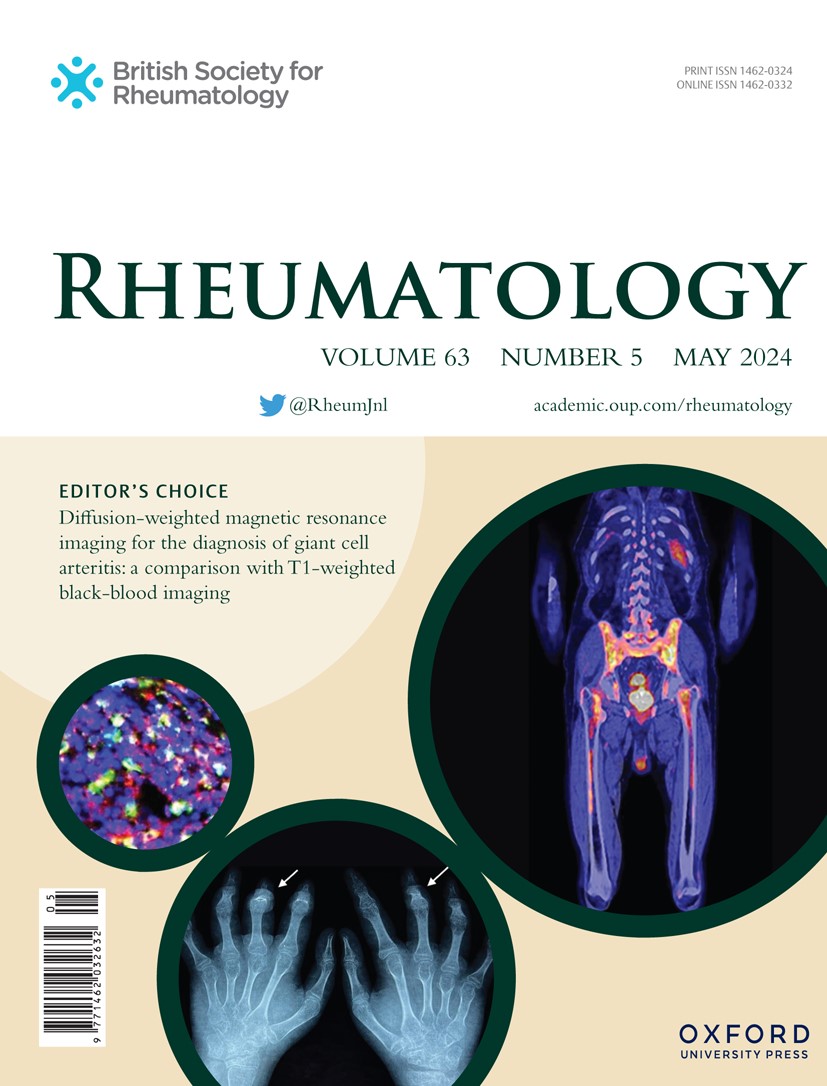Efficacy and safety of a millimetre wave medical device for pain neuromodulation in peripheral osteoarthritis: a crossover randomised trial.
IF 4.4
2区 医学
Q1 RHEUMATOLOGY
引用次数: 0
Abstract
OBJECTIVES To manage osteoarthritis (OA)-related pain, current guidelines recommend a combination of non-pharmacological and pharmacological treatments. The objective of this study was to assess a millimetre-wave-emitting medical device (MD) for neuromodulation of pain in patients with peripheral OA. METHODS In this monocentric, prospective, crossover, randomised controlled trial, 60 patients with peripheral OA affecting joints (ankle, knee, hip, shoulder, elbow, and fingers) and a pain score ≥ 4 on the Visual Analogue Scale (VAS) were recruited and randomly assigned to one of two crossover sequences. The primary outcome was self-assessed pain, while secondary outcomes included life and sleep quality. RESULTS Of the 60 patients included, 31 were randomly assigned to the OFF/ON sequence and 29 to the ON/OFF sequence. The baseline mean pain scores for the groups was 6.05 (SD = 1.36) and 6.31 (SD = 1.52) on the VAS, respectively. During the MD use period, the mean daily VAS pain score was 4.57 (SD = 2), compared with 5.32 (SD = 1.77) during the period without MD use. The mean paired difference between periods was 0.74 (SD = 1.77). This difference was statistically significant (p= 0.002). The corresponding effect size was 0.42. No carryover, sequence, or period effects were observed. Secondary outcomes related to quality of life and sleep quality showed significant improvement with MD use. No serious adverse events were reported. CONCLUSION In patients with peripheral OA, regular use of this MD significantly reduced in pain (VAS), improved both quality of life (EQ5D-5L) and sleep quality (VAS). Future research should focus on individualised benefit-risk balance, incorporating patient preferences. CLINICAL TRIALS REGISTRATION ClinicalTrials.gov; NCT04590079.毫米波医疗设备对周围性骨关节炎疼痛神经调节的有效性和安全性:一项交叉随机试验
目的:为了治疗骨关节炎(OA)相关疼痛,目前的指南推荐非药物和药物联合治疗。本研究的目的是评估毫米波发射医疗装置(MD)对周围性OA患者疼痛的神经调节作用。方法在这项单中心、前瞻性、交叉、随机对照试验中,招募60例影响关节(踝关节、膝关节、髋关节、肩部、肘关节和手指)且视觉模拟评分(VAS)疼痛评分≥4分的周围性OA患者,并随机分配到两个交叉序列中的一个。主要结果是自我评估的疼痛,而次要结果包括生活和睡眠质量。结果纳入的60例患者中,31例随机分配到OFF/ON序列,29例随机分配到ON/OFF序列。各组的基线平均疼痛评分分别为6.05分(SD = 1.36)和6.31分(SD = 1.52)。在MD使用期间,平均每日VAS疼痛评分为4.57 (SD = 2),而未使用MD期间为5.32 (SD = 1.77)。周期间平均配对差为0.74 (SD = 1.77)。差异有统计学意义(p= 0.002)。相应的效应量为0.42。没有观察到延续、序列或周期效应。与生活质量和睡眠质量相关的次要结果显示,使用MD显著改善。无严重不良事件报告。结论对于外周性OA患者,定期使用该MD可显著降低疼痛(VAS),改善生活质量(EQ5D-5L)和睡眠质量(VAS)。未来的研究应侧重于个体化的利益-风险平衡,并结合患者的偏好。临床试验注册网站clinicaltrials .gov;NCT04590079。
本文章由计算机程序翻译,如有差异,请以英文原文为准。
求助全文
约1分钟内获得全文
求助全文
来源期刊

Rheumatology
医学-风湿病学
CiteScore
9.40
自引率
7.30%
发文量
1091
审稿时长
2 months
期刊介绍:
Rheumatology strives to support research and discovery by publishing the highest quality original scientific papers with a focus on basic, clinical and translational research. The journal’s subject areas cover a wide range of paediatric and adult rheumatological conditions from an international perspective. It is an official journal of the British Society for Rheumatology, published by Oxford University Press.
Rheumatology publishes original articles, reviews, editorials, guidelines, concise reports, meta-analyses, original case reports, clinical vignettes, letters and matters arising from published material. The journal takes pride in serving the global rheumatology community, with a focus on high societal impact in the form of podcasts, videos and extended social media presence, and utilizing metrics such as Altmetric. Keep up to date by following the journal on Twitter @RheumJnl.
 求助内容:
求助内容: 应助结果提醒方式:
应助结果提醒方式:


